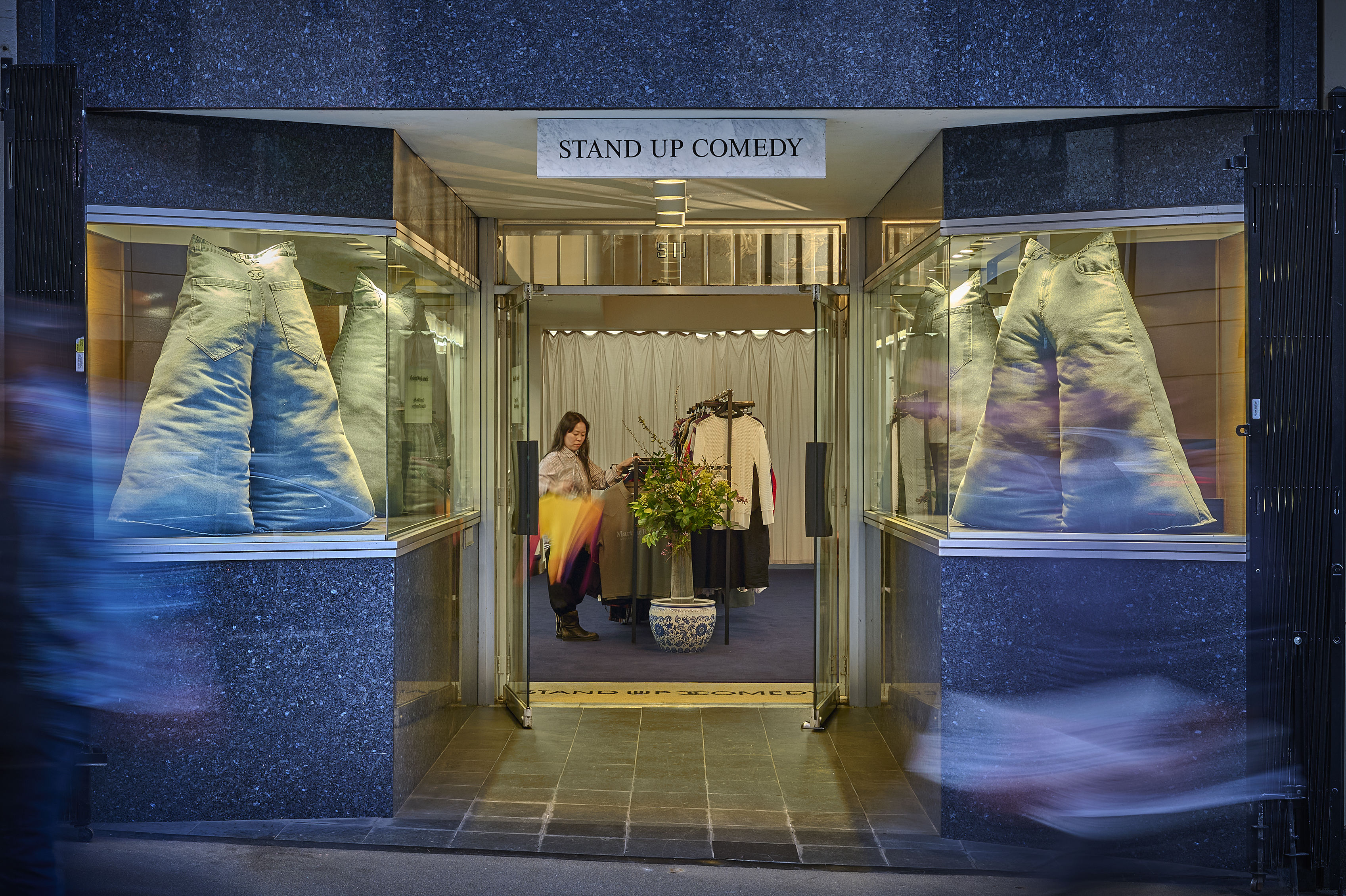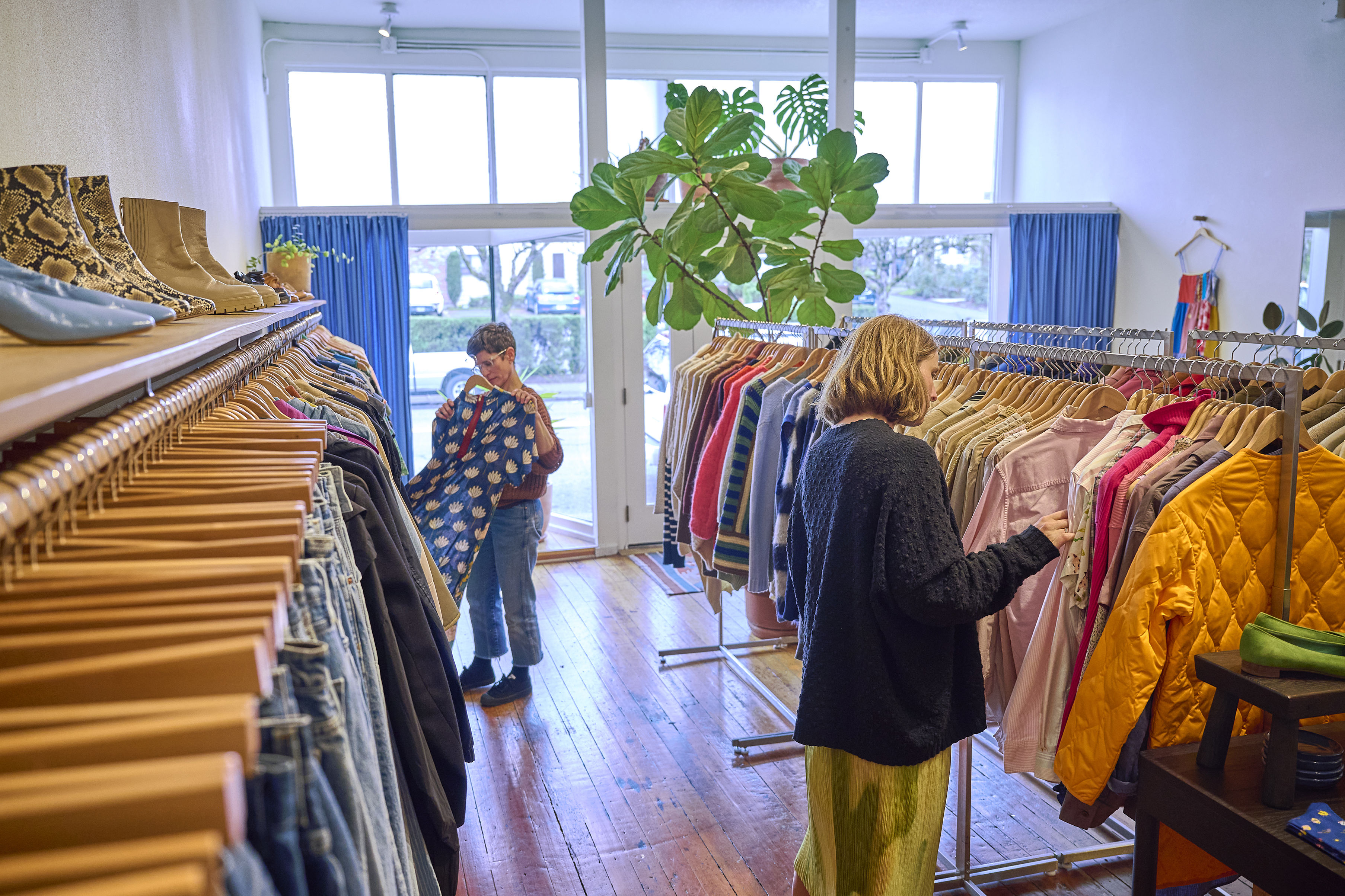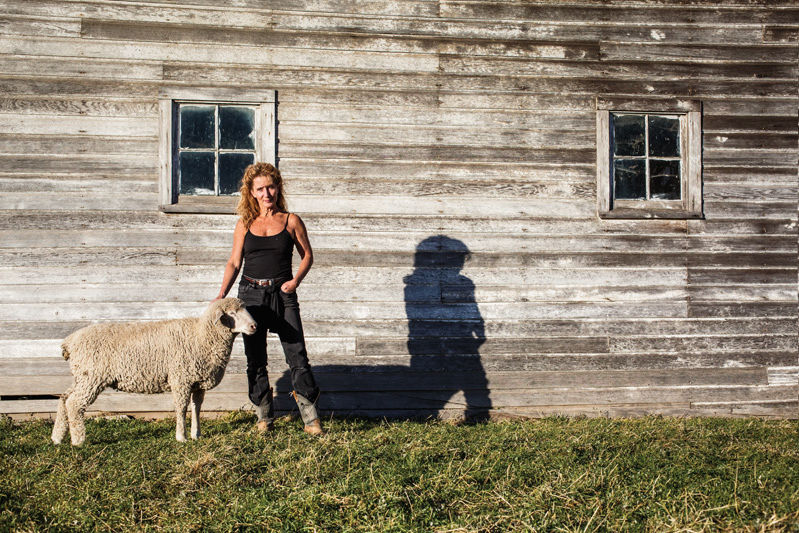
A Historic Oregon Ranch is Crusading to Revive the American Clothing Industry
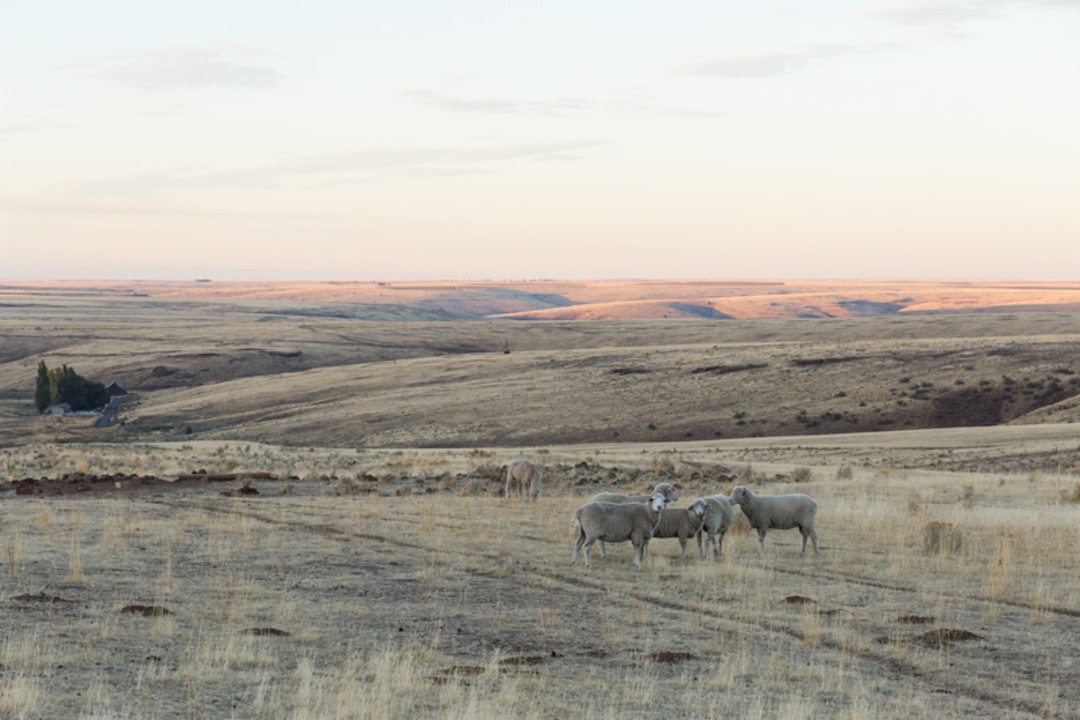
Imperial Stock Ranch’s vast Central Oregon acreage
Image: Stuart Mullenberg
“Normally, I would wear my fringed skirt,” says Jeanne Carver, “but someone reminded me I should wear a piece from the collection. I do have my boots on, so I still feel like myself.” On a warm afternoon in late September, Mercantile, a high-end women’s clothing shop in downtown Portland, throws a party to launch the Imperial Collection by Anna Cohen. Six years in the making, the clothing line is a collaboration between Carver, who owns the new brand and provides wool for it from the historic Imperial Stock Ranch, and Molalla-born Cohen, a designer known for sustainable materials and stylish, Italian-influenced aesthetics.
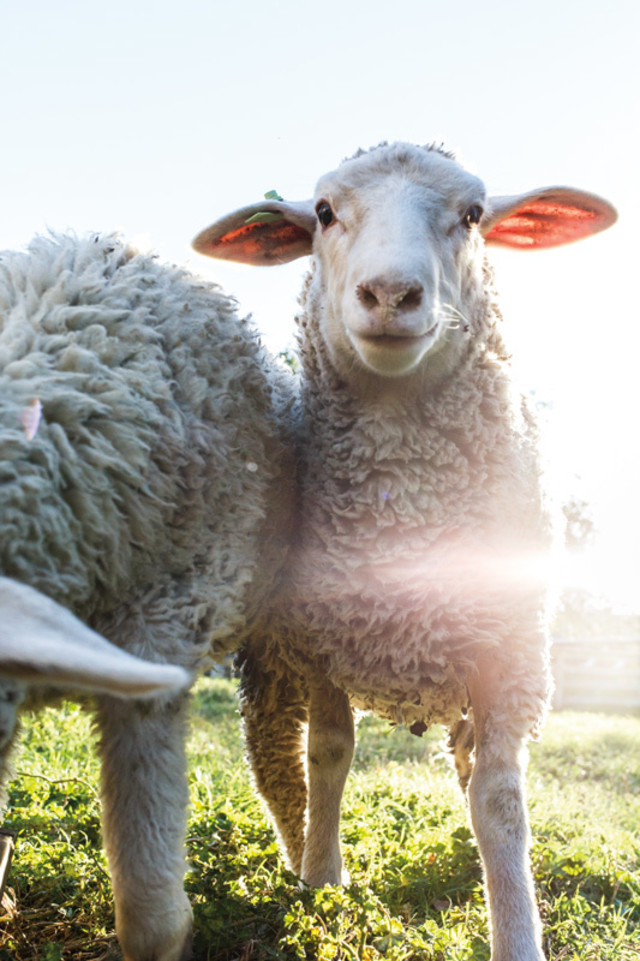
Imperial sheep
Image: Stuart Mullenberg
Racks in the center of the high-ceilinged shop display hand-knit sweaters, woven woolen dresses, shearling vests and jackets, and shelves of blankets and throws. A special display includes puffs of raw wool and sheep-shearing implements, including a long, soft-soled felt shearing bootie, like footwear in a fairy tale. Another showcases the eye-popping red, white, and navy cardigan worn by Team USA in the opening ceremony of the 2014 Sochi Olympics, made by Ralph Lauren with Imperial’s branded yarn.
A waiter drifts past, offering bay shrimp with endive and microgreens in a sesame cone. It’s that kind of scene: moneyed, fashion-forward west siders, as well as a handful of avid knitters who are fans of the yarn from Imperial, which Carver co-owns with her husband, Dan. Yet Carver doesn’t seem to be in a celebratory mood. She’s warm and exuberant, but also treats every encounter as a chance to tell her story, which she does with astounding passion and frequency. This gathering is just one installment in Carver’s mission to preserve the 144-year-old ranch’s sheep operation, in large part by tapping into the growing popularity of specifically sourced food and fashion. Launch parties and fancy apps aside, the long-term success of Carver’s endeavor very much remains to be seen.
Carver possesses cowgirl glamour, with a mop of tousled blond hair and beach-glass-green eyes. Her skin’s testament to sun and weather only adds to her charisma. She wears a piece called the Charlie, a knit shirtdress with snowflake-diamond-pattern sleeves that hits just above the knee, paired with well-preserved cowboy boots. At 60, she retains the physique of the college track star she once was, and she brims with anecdotes, stories, and information. Information overload, in fact.

Image: Stuart Mullenberg
Moments after we meet, she starts throwing around textile manufacturing terms I need to look up on my phone the moment she turns her back. Soon she tells me, with precision, that in 2013 the Imperial Stock Ranch generated $2.6 million in economic stimulus dollars, including work generated for the 18 “value chain partners” who transform the wool into finished goods. She is enthusiastic and animated, with something of an evangelist’s headlong zeal.
As Carver reaches for a bottle of Gatorade, Cohen slides up and puts an arm around her waist. Cohen wears her own Carmen dress, a wrap of sueded silk charmeuse matching her red lipstick. Her affection for Carver is apparent. “Maybe a glass of wine?” she says. Carver just laughs and takes a swig of Gatorade. She is not a woman who cares much about social niceties. She is focused on one thing: keeping sheep on her land. And that is more challenging than you might imagine.
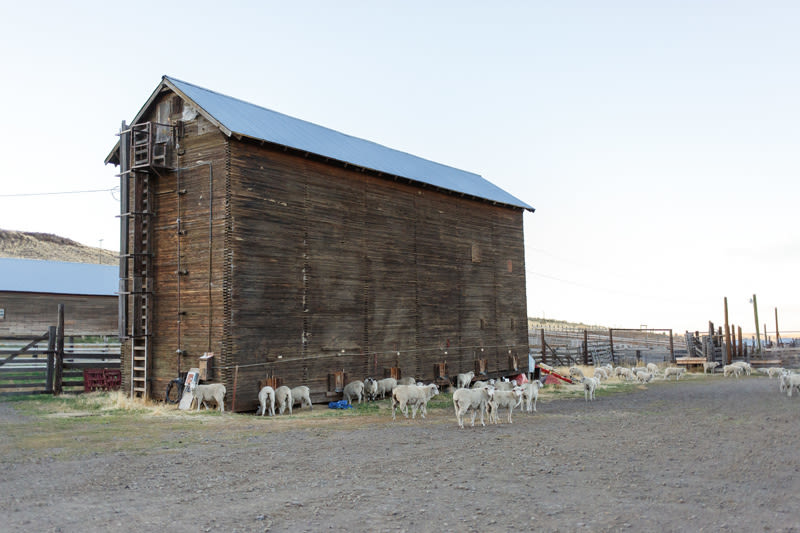
Image: Stuart Mullenberg
The 50-square-mile Imperial Stock Ranch sits on the Columbia Plateau, 120 miles southeast of Portland, smack in the middle of a spectacular nowhere. The plateau is cut by rocky ridges and deep canyons, the rolling, dun-colored hills dotted with clumps of yellow flowering rabbitbrush. On an average day, a highly Instagrammable view from halfway down the ranch’s three-mile gravel drive encompasses the Cascades to the north: Mounts Hood, Adams, Rainier and Baker, near the Canadian border. The grain elevator in Kent, 25 miles away, is easily visible in the distance. Annual rainfall averages 8 to 10 inches a year, but the day
I visit the skies hang low with blue-gray clouds.
Carver meets me on a rise in the road to begin my tour. The ranch has raised sheep and cattle and grown hay and grains since 1871. Its headquarters buildings are on the National Register of Historic Places. As wind kicks up and drizzle begins to fall, she leads me into a field and breaks off a golden stalk of bunchgrass. “Grazing animals were put on this earth for a reason,” she begins. “To bite the grass. Harvesting grass is what they’re here for.” She goes on to say how the sun is captured in the grass, then passed on to the sheep’s wool, hide, and meat. “The yarn we make, and the garments we make from it, are harvested sunlight.”
A pickup truck pulls up, and her husband climbs down from the cab. Dan Carver looks like a rancher, long-legged and laconic, with a worn denim jacket and an equally battered cowboy hat. Raised on a small cattle ranch in Tillamook County, he paid his way through Oregon State by logging in the summers, as his father and grandfather did before him. He purchased the ranch in 1988, and married Jeanne in 1991. You wouldn’t peg him as a radical, but an absolute belief in sustainability has largely shaped his career. In 1996, the Carvers converted to no-till farming to conserve soil quality. That year, their yields increased, and they reduced their fossil fuel bill by $20,000. “If the land wins, the pocketbook wins,” says Jeanne Carver.
The Carvers are only the fourth owners of the Imperial Stock Ranch. The founder, Richard Hinton, born in 1852 in an oxcart during his family’s trip west on the Oregon Trail, expanded his original 160-acre claim into the biggest stock holding company in Oregon and one of the largest sheep operations in the West. At one point, Imperial consisted of 70,000 contiguous acres. In 1915 Hinton passed the ranch on to his son, James, who had no heirs, and in 1945 James brought a trusted ranch hand named George Ward in as partner. When Dan Carver bought the ranch four decades later, he promised Ward that he would “keep it as it was.”
According to his wife, Dan likes to say the ranch is “90 miles north of Bend and a hundred years away,” and on first glance the place does seem a frontier throwback. Because the climate is semiarid, the wooden headquarters and outbuildings endure in a way they never could west of the Cascades. The three-story Queen Anne “mansion,” completed in 1900, currently houses the offices of Imperial Yarn. The bunkhouse, icehouse, and shearing shed all stand, pieces of living history. A wooden grain elevator, circa 1940, often
attracts University of Oregon architecture students.
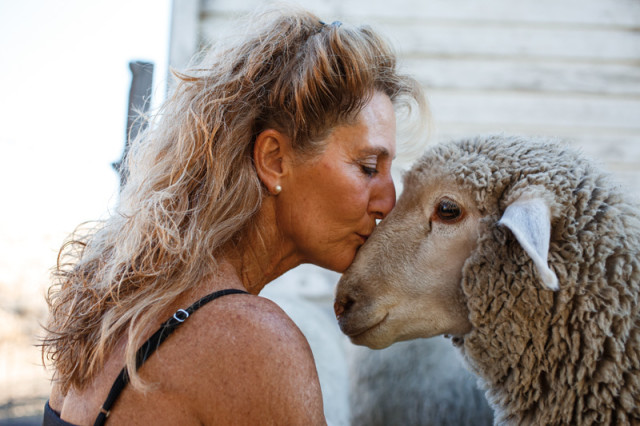
Jeanne Carver and a woolly friend
Image: Stuart Mullenberg
At ranch headquarters, a handful of lambs and young sheep, runts and orphans whom Carver bottle-feeds herself, live in the fenced yard of outside the historic Hinton house. As she opens the gate, they trot toward her for a pat on the head or kiss on the nose. She points out a favorite, Sochi, who rode on her lap to Portland last year for a yarn festival. I comment on how cute she is. Carver says, “She’s my love.”
The businesses the ranch competes in, however, have traditionally been anything but sentimental. Fifteen years ago, even fine restaurants preferred to import frozen lamb from overseas. In the early ’90s, one of Imperial’s “longtime wool buyers” (Jeanne Carver declines to name names) suddenly dropped the ranch. She still tears up relaying how she was told flat-out that the client had no more use for her harvested sunlight, which had become comparatively expensive to process and had lost its market. People wanted light, synthetic fabrics they could toss in the wash. “People were saying I might as well burn it,” she recalls. “I didn’t bother saying good luck with that—it’s naturally fire retardant.”
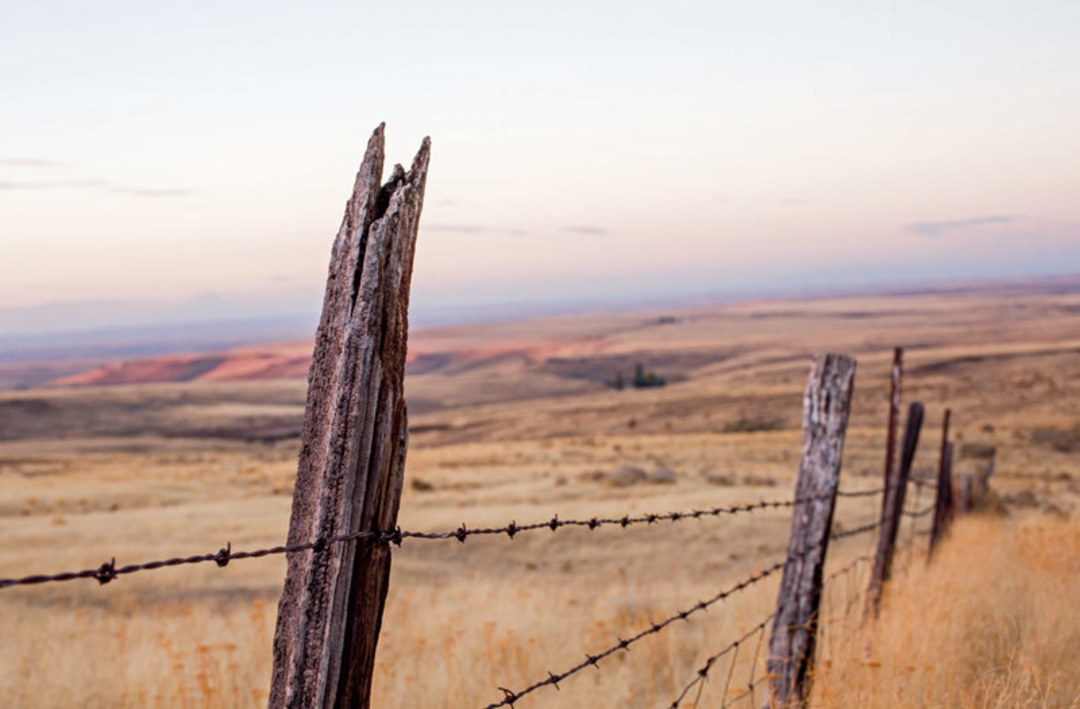
Image: Stuart Mullenberg
This bad news reflected several decades of big changes in both the textile and sheep industries. Textile manufacturing in America has always sought the cheapest labor and production conditions available. The first mills exploited New England’s waterpower. When steam power replaced water, the mills moved south. When the developing world opened up, they moved overseas, notably to China. Now that wages are rising in China, other low-cost nations—Vietnam, Myanmar, Bangladesh—have entered the fray. By the late 20th century, almost 90 percent of American textile manufacturing had moved offshore. The only option for most American sheep producers—26,000 failed in the ’90s alone—was to ship wool overseas for virtually nothing. Abroad, it would be processed, spun into yarn, made into apparel, and sold back to American consumers. This happened despite the continuing existence of high-quality mills in the US; Carver does business with one in New England that routinely operates at 20 percent capacity.
Necessity may be the proverbial mother of invention, but a metaphysical sense of mission helps, too. “I’m in a servant role here,” says Carver. “This isn’t about me. It’s not even about the Imperial Stock Ranch. We’re honoring the land, the animals, and the interconnected relationships that give life to man.” Carver has shouldered the role of, as she characterizes herself, “one woman hollering out in the middle of nowhere.” It would be hard to find anyone better suited to the task.
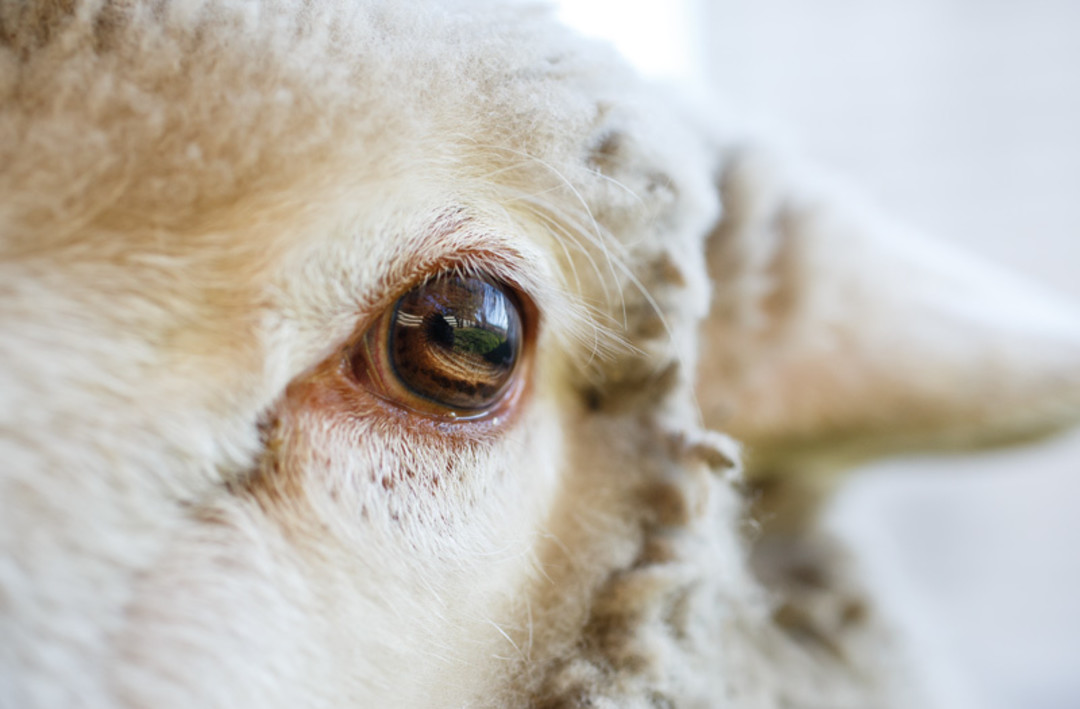
Image: Stuart Mullenberg
Carver’s father was a road builder, and she and her sister grew up in far-flung corners of the Northwest, mostly in road camps. She didn’t mind. She was a tomboy who loved the outdoors, horses, and running. After high school, she enrolled in Oregon College of Education (now Western Oregon University) in Monmouth. “It was the first time I’d ever lived in a town,” she says, “and the world opened up for me.” She ran hurdles on the track team (both indoor and outdoor) and became an all-star volleyball player. Before she graduated, Willamette University recruited her to coach both sports—the school waived its requirement that she have a master’s in education on the condition she complete one in three years. (Which she did, in biomechanics, based on her analysis of hurdling). By the time she was 30, she’d coached Division I and US national team athletes.
“All of the years of competitive athletics almost prepared me for this current challenge,” she says. We’re eating lunch at the dining room table in the low-slung, brown brick ranch house she shares with Dan and ample evidence of their many endeavors. Blankets in plastic casing pile high on the hearth. In the den, another pile teeters on an exercise treadmill, while samples from Cohen’s Imperial Collection pack a rack in the middle of the room. Down the hall, in the guest room, another rack holds a stylish lambskin vest, designed by Carver herself, with buttons made from the shed antlers of elk.
“People loved our yarn, but didn’t all love to knit,” Carver recalls. “So I began hiring knitters and weavers in Central Oregon to make scarves and shawls.”
Thus, the core of Carver’s mission, and her challenge. The ranch can make money in various ways; it does good business in cattle, hay, and grain, for instance. But Jeanne and Dan are determined to preserve the full scope of the historic operation, which includes keeping sheep on the land. In her self-appointed “servant role,” she constantly searches for new business models and opportunities to further that cause.
In 2007, she stumbled upon a magazine profile of Cohen, who’d already received accolades for pioneering sustainable fashion. Carver cut out the article. Aware that Imperial’s unusual story is one of its greatest assets, she envisioned a new chapter: a ranch-to-runway fashion enterprise that could do its part to revitalize demand for her wool. On Mother’s Day 2008, she invited Cohen and her mother out to the ranch. “I thought, whatever is happening here,” says Cohen, “I want to be of service to it. I could see that I could help her.”
Cohen and Carver agreed to work together. Some sample designs premiered at Portland Fashion Week in 2009, but the breadth of Cohen’s design aspirations—dresses, blazers, skirts, and pants—demanded more production partners. Meanwhile, Imperial’s yarn business grew rapidly, with sales increasing sevenfold in 18 months over 2011–12. That growth also slowed any move into apparel. But in 2013, Cohen recalls, she was leaving a job interview at Nike when Carver called with news of a $300,000 USDA grant that would make Imperial’s leap into fashion possible. In the meantime, fashion came calling on its own.
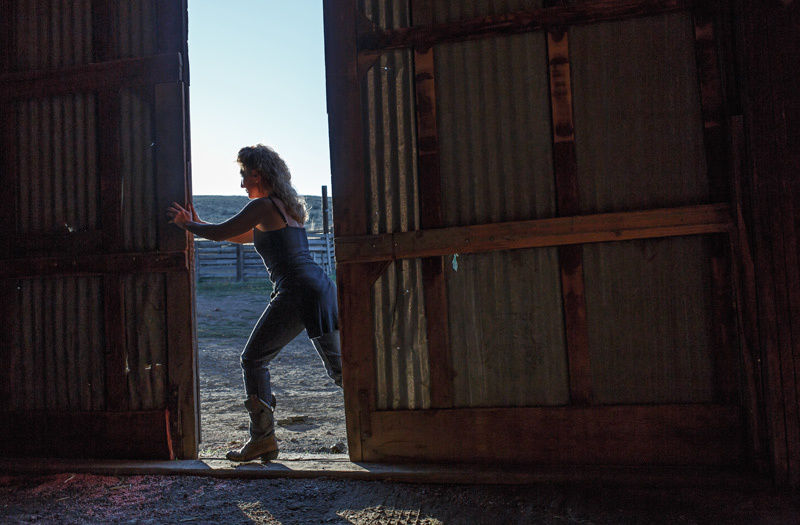
Image: Stuart Mullenberg
Carver tells a great story. Even though I’d already heard about the Ralph Lauren call from someone else, I wanted to hear her tell it.
July 2012. She and Dan worked all morning, then she came inside to return some phone calls. One was from someone named Robert.
“He just starts asking me all about the yarn. He’s talking real fast, and he hasn’t introduced himself. I interrupt him: ‘What yarn store are you with? So I can do a better job of helping here?’ And he says, ‘I’m not with a yarn store. I’m with product development for Polo Ralph Lauren.’
‘Come on, who is this?’
‘I’m serious. I’m sitting right here on Madison Avenue.’
‘I’m sitting here in the Oregon desert. In fact, a group of sheep who’ve been into the spring here on the hillside are about to head on out, and you can probably hear them.’
I held the phone up, and you could hear them, the ewes calling their lambs, maaaa maaaa maaaa, and the bells tinkling and they went.
‘That’s amazing,’ he said.
‘What’s amazing is that you’re calling me. How’d you find me?’
‘I was in a luxury yarn shop in New York and told them I was looking for an American yarn for a special project. They said I needed to call the Imperial Stock Ranch in Oregon.’”

The Frances sweater from Anna Cohen’s Imperial Collection
Image: Stuart Mullenberg
Not long after, a Ralph Lauren design team toured the ranch. The company ordered some samples, and then some more, back and forth for a good six months. For a long time, Carver didn’t know exactly what they were working on. In October 2013, Ralph Lauren announced that Imperial wool would garb the US Olympic team as it marched into the Sochi opening ceremonies. (Congress and the media had lambasted Ralph Lauren for dressing US athletes in foreign-made uniforms for the London Olympics in 2012.) Nine thousand
e-mails flooded Carver’s in-box, many from stores, designers, and fashion firms interested in Imperial wool. Today, Carver says she’s talking to more than 60 manufacturers.
In many ways, the zeitgeist has caught up with the woman hollering from the middle of nowhere. The Carvers embraced sustainable farming, grass-fed meat, and domestic manufacturing ahead of the trends. Hipsters, millennials, and “making” enthusiasts love to knit. I consulted one of the yarn gurus at Twisted, my local yarn shop in Northeast Portland, and she reported selling a ton of Imperial yarn, enthusing about its “fluffy” quality and its reasonable price point. (For $80, you can knit a sweater.) Apparel makers are also embracing the Made in USA ethos. “I’m accidentally on the leading edge of the reshoring of the American textile industry,” Carver marvels.
At Mercantile, I tried on one of the collection’s best sellers, the thigh-length Olivia cardigan. It was heavy, warm, and well constructed. I could imagine passing it on to my daughter. The price tag is $595. You really do get what you pay for—in this case an elegant piece sourced in our own state, made in our own country. For Jeanne and Dan Carver, the biggest question remains: is there a market big enough for such high quality?
“This is rural ranchers, trying to sell what they produce in a new way,” Carver says. “We’re little guys, but we’re providing a tangible link to the source of wool and the ethic of slow fashion—knowing where it comes from. This has been a 15-year battle of saying that matters.”


